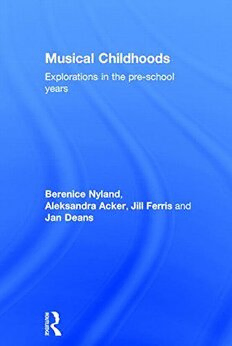Table Of ContentMUSICAL CHILDHOODS
Musical Childhoods is a culmination of more than a decade of research driven by the fact
that music has been neglected in early childhood programmes in favour of literacy and
numeracy. Recent research has identifi ed a connection between academic performance
and musical programmes and this has given music a renewed status in many schools.
This book promotes the idea of children’s competence in the use of the language
of music and argues that all children have a right to participate in musical discovery,
celebrating children’s engagement with meaningful and disparate experiences in
music. Written by leading practitioners and researchers in the fi eld, this book seeks
to reaffi rm children’s communicative competence when exposed to high-quality
musical experience, provide new perspectives on children’s ability to engage with
music in many diverse forms and explore and promote the role of the musician as
an artist and teacher.
The book is structured in three parts:
• The theoretical overview
• The children, the musicians and the music
• The research through the eyes of the protagonist and looking into the future.
Early childhood students, researchers and academics with a specifi c interest in music
and musicality will fi nd this an insightful read.
Berenice Nyland is Associate Professor in early childhood at RMIT University in
the School of Education, Australia.
Aleksandra Acker is a practising musician and an early childhood academic in the
School of Education, RMIT University, Australia.
Jill Ferris is a practising musician. She has been a music educator and a lecturer in
music education at the School of Education, RMIT University, Australia.
Jan Deans is Senior Lecturer in early childhood and Director of the Early Learning
Centre at the University of Melbourne, Australia.
MUSICAL CHILDHOODS
Explorations in the
pre-school years
Berenice Nyland, Aleksandra Acker,
Jill Ferris and Jan Deans
Routledge
Taylor & Francis Group
LONDON AND NEW YORK
First published 2015
by Routledge
2 Park Square, Milton Park, Abingdon, Oxon OX14 4RN
and by Routledge
711 Third Avenue, New York, NY 10017
Routledge is an imprint of the Taylor & Francis Group, an informa business
© 2015 B. Nyland, A. Acker, J. Ferris and J. Deans
The right of B. Nyland, A. Acker, J. Ferris and J. Deans to be identifi ed
as the authors of this work has been asserted by them in accordance with
sections 77 and 78 of the Copyright, Designs and Patents Act 1988.
All rights reserved. No part of this book may be reprinted or reproduced
or utilised in any form or by any electronic, mechanical, or other means,
now known or hereafter invented, including photocopying and
recording, or in any information storage or retrieval system, without
permission in writing from the publishers.
Trademark notice : Product or corporate names may be trademarks or
registered trademarks, and are used only for identifi cation and
explanation without intent to infringe.
British Library Cataloguing in Publication Data
A catalogue record for this book is available from the British Library
Library of Congress Cataloging-in-Publication Data
Musical childhoods : explorations in the pre-school years / Berenice Nyland,
Jill Ferris, Aleksandra Acker and Jan Deans.
pages cm
ISBN 978-0-415-74005-0 (hardback) – ISBN 978-0-415-74006-7 (pbk.) –
ISBN 978-1-315-81467-4 (e-book) 1. Music–Instruction and study–Juvenile.
2. Education, Preschool. I. Nyland, Berenice. II. Acker, Aleksandra.
III. Ferris, Jill. IV. Deans, Jan.
MT1.M987363 2014
372.87–dc23
2014034735
ISBN: 978-0-415-74005-0 (hbk)
ISBN: 978-0-415-74006-7 (pbk)
ISBN: 978-1-315-81467-4 (ebk)
Typeset in Bembo
by Cenveo Publisher Services
DEDICATION
We would like to dedicate this book to the children, families and staff of the Early
Learning Centre. All participated generously in the research described here. The
musicians allowed themselves to be observed and shared their plans and refl ections,
while participating staff were always welcoming and supported the research in many
ways. For example, their own digital recordings of music sessions were shared and
when asked about attending interviews all were willing to give up the time. The
interview transcripts are also indicative of thoughtful contemplation about the pro-
gramme and the differing roles. The children are especially remembered for their
unique responses to the events described here and their good-hearted collaboration
with adults and each other. Their freshness of approach and ability to be playful
made this research a pleasure. The parents’ enthusiasm for the music was also an
essential part of this ongoing initiative.
This page intentionally left blank
CONTENTS
List of fi gures ix
List of tables x
Acknowledgements xi
Abbreviation and terminology xii
PART I
The context 1
1 Y oung children, music and early childhood programmes 3
2 Early childhood arts education: a case study 17
PART II
The music 33
3 A search for meaning and communicative competence
through the language of music 35
4 Singing: a way of life 55
5 Young children, music and musical content 72
6 A n early childhood educator 89
viii Contents
7 T he Early Learning Centre choir 105
8 T he child’s voice 124
PART III
Conclusion 143
9 Revisiting and concluding remarks 145
References 160
Index 166
FIGURES
3.1 M ’s drawing of the sound falling 44
3.2 T he scene for the ‘Little Green Frog’ song 48
3.3 T he tone block guiro 50
3.4 B ell bird 52
4.1 M usic with Leah (1) 65
4.2 M usic with Leah (2) 67
5.1 C hildren’s drawing of Papageno 82
5.2 C hildren’s drawing of the Queen of the Night 83
5.3 S arastro 84
5.4 P amina 85
5.5 H ow do you make a bear look like a butterfl y? 86
6.1 P age of curriculum book 97
7.1 ‘ The Eucalypt Tree’ 113
7.2 C hild’s notation 118
7.3 C hild’s notation and pictures 118
7.4 N otation, pictures and words 119
8.1 L ’s symphony 135
8.2 S inging by the river 138
8.3 C onducting 139

